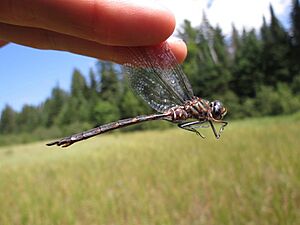Incurvate Emerald facts for kids
Quick facts for kids Incurvate Emerald |
|
|---|---|
 |
|
| Female in fen breeding habitat | |
| Conservation status | |
| Scientific classification |
The incurvate emerald (Somatochlora incurvata) is a type of dragonfly. It belongs to the Corduliidae family, also known as the emerald dragonflies. You can find this beautiful insect in parts of Canada and the United States. It especially loves to live in wet, marshy areas called fens.
Contents
Discovering the Incurvate Emerald
The incurvate emerald was first officially described in 1918. A Canadian insect expert, called an entomologist, named Edmund Murton Walker studied it. He based his description on dragonflies he found in Whitefish Point, Michigan. At first, he wondered if it was just a local version of a similar dragonfly, the forcipate emerald.
What Does the Incurvate Emerald Look Like?
The incurvate emerald is a medium-sized dragonfly. It is long and slender, growing to about 5.8 centimeters (about 2.3 inches) in length. This makes it larger than many other dragonflies in its group, the Somatochlora genus. Its body, including its chest (thorax) and tail (abdomen), is a shiny metallic brown or black. It also has yellowish-brown spots along its sides. A cool fact is that its eyes are a bright green color!
Where Do Incurvate Emeralds Live?
This dragonfly has a specific home range in northeastern North America. You can find it from Nova Scotia in Canada, south to New York, and west to Wisconsin. It doesn't live everywhere, but it can be found in these areas.
Incurvate Emerald Habitat
Incurvate emeralds prefer to live in wet, spongy areas. These include bogs and fens. Fens are wetlands fed by groundwater, which makes them different from bogs. Young dragonflies, called larvae, are thought to live deep within wet Sphagnum moss. Adult dragonflies lay their eggs in small pools within these breeding spots. Sometimes, they even use temporary puddles made by footprints! While they breed in these wet areas, adult dragonflies might fly to other places to hunt for food.
Life Cycle and Diet
Like all dragonflies, the incurvate emerald has a fascinating life cycle. Both the young larvae and the adult dragonflies are predators. They hunt and eat smaller insects and other tiny creatures. Adult incurvate emeralds are active during the day, flying around from June to October. When winter comes, the species survives as larvae, waiting for warmer weather to continue growing.
Protecting the Incurvate Emerald
For a long time, people thought the incurvate emerald was very rare. However, more recent studies have shown that it's actually quite common in some parts of its range. Even so, there are still some things that could threaten them. These include activities like harvesting peat (a type of soil from wetlands) and cranberry farming. Water pollution and changes to water levels in their habitats can also be harmful. Globally, the incurvate emerald is considered secure (G5 ranking). However, it is still considered rare in many of the individual states and provinces where it lives.


